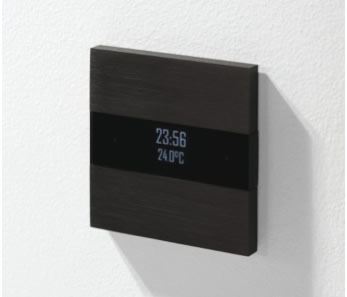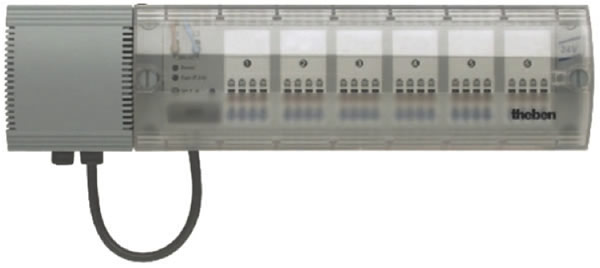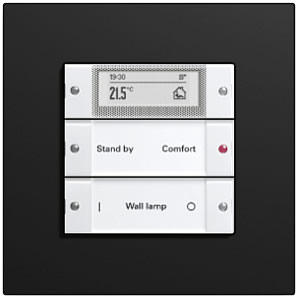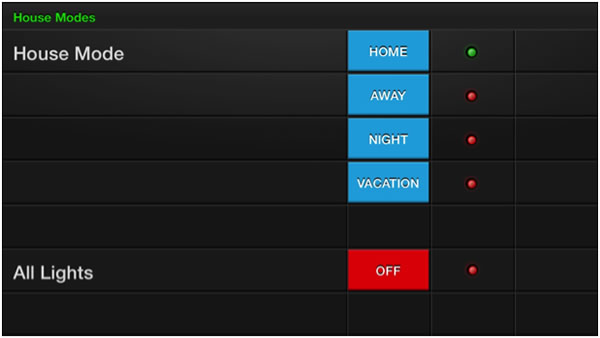 By Charlotte Blissett-Griffiths, Ivory Egg (UK) Ltd.
By Charlotte Blissett-Griffiths, Ivory Egg (UK) Ltd.
We are approaching the time of year when the temperature starts to drop and we are all left reaching for the thermostat. Heating control can often be daunting for integrators and even more so for customers, so a balance needs to be struck between the customer’s desire for control and a system’s ability to maintain a constant and comfortable temperature.
When embarking on a heating project for the first time, there are many pitfalls that an integrator can face. KNX enables the integrator to install an effective heating control system easily, allowing the customer to have a high level of control.
KNX switches are often multifunctional; incorporating heating, lighting and blind control. Some may simply be beautiful switches, whilst others have features such as a temperature display. Providing temperature displays in every room may sound sensible, but a customer may then be tempted to adjust the temperature too often, creating temperature swings that will only lead to inefficiencies and discomfort.

Avoiding Unnecessary Adjustment
A digital display has the benefit of enabling the user to see the room temperature, but as we have found, this can be counterproductive. It may make more sense to display the setpoint temperature instead since, provided the heating system is well specified and working effectively, the setpoint will be a good approximation of the actual temperature. In addition, if the temperature is maintained at a constant, the occupants will gain confidence in the system and learn to trust it.
As you can imagine, there is also a huge subjective element to comfort. Someone who has just come in from the cold will have a radically different response to the temperature inside the home compared with someone who has been watching TV in the living room for an hour. One person’s perception of 21°C can therefore be far different from someone else’s, based upon their current experience. A heating system that displays the desired setpoint rather than the actual temperature can reassure users that the heating system is actually doing its job, and prevent unnecessary user adjustment.
Heating with KNX
Heating with KNX is very simple. There are three broad stages required to manage heating and cooling, namely input, regulation and output. At least two inputs are required: the actual temperature in the room and the desired temperature or setpoint. The regulation uses these two values in its algorithm to generate and update the amount of additional heat required (the heating demand). This is then used by the output stage to drive a valve actuator or switch.

Since many KNX switches include temperature sensing, if not full temperature regulation, the temperature sensing step could not be easier. More importantly, no extra work is required, nor is there any extra hardware to add to the wall to create unsightly wall acne.
KNX-controlled light switches can regulate the temperature in the home, keeping energy levels efficient. They can be programmed to the customer’s desired ambient temperature and the KNX intelligence will regulate it automatically if there is a change in the room’s ambient temperature.

There is often a requirement or assumed requirement from the customer to have detailed room by room adjustment of temperature. On the face of it, this sounds sensible, but it can result in all sorts of problems, not least of which is ending up with lots of different setpoints all over the house which become laborious to manage. Effective setpoint adjustment is key for an easy-to-use heating system and a happy customer. Indeed various levels of control have been tried and tested by Ivory Egg system integrators, with the following results:
Complete control but greater complexity
The user must manually adjust the temperature in every room. This gives the user a high level of physical control but it is not the most efficient option. It is time- consuming to change every setpoint. Even if global control is provided, this approach often provides more information than is necessary, and ends up confusing the occupants of the home.
Limited control with increased ease
The customer adjusts only the overall setpoint of the home, or in a very few zones, such as living areas and sleeping areas. KNX devices then regulate these zones, by reading the temperature in each room. The benefit to this approach is that there are limited places where adjustment is necessary. Adjustment can be performed manually on just a few thermostats, or even by using a mobile app. Changes made in one room can then be copied to the regulation devices in other zones.
Home-wide modes and the greatest ease
All KNX regulation devices offer standard heating modes such as Comfort, Standby, Economy and Frost protection. Often these labels don’t mean much to users, however KNX provides the ability to re-label these modes in order to personalise them for the customer. Scene control enables an integrator to define Home, Away, Night and Vacation scenes, for example. These scenes can be easily selected by the customer, from a central location, perhaps in a hallway or kitchen, offering convenient building control.
By using KNX, we can also add further functions to these scenes. For example, the Away scene can switch off all lights, shut windows, disable presence detectors and provide feedback in addition to changing the heating mode.

Conclusion
Home-wide control tends to be the most popular approach for systems integrators and their customers. This approach enables the customer to feel as if they are getting the most from their home automation system. By using home-wide control, we also take advantage of a more energy-efficient approach to heating and our end-clients get a much more comfortable home as a result.
Charlotte Blissett-Griffiths is the Marketing Coordinator for Ivory Egg (UK) Ltd, a supplier of leading KNX products and provider of KNX training courses. Ivory Egg runs a number of training courses on how to achieve heating/cooling control with KNX.











